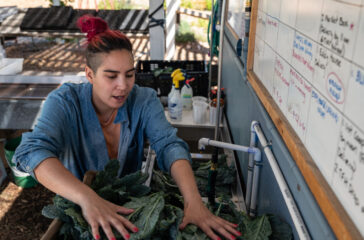By Keith Schneider
For decades, leading US farm leaders have likened efforts to rein in harmful climate change as attacks on agriculture itself, aligning with oil and gas industry groups to block policies aimed at reducing greenhouse gas emissions.
That stance has slowly been shifting in recent years, and now, fueled by $3.1 billion in federal grants, farm country is poised to shape a new era of “climate-smart” agricultural practices and take a significant role in addressing the dire consequences of a warming planet.
The actions can’t come fast enough. A panel of international scientists warned this month that the world faces a “rapidly closing window of opportunity to secure a liveable and sustainable future,” and that the actions implemented over the next few years will have consequences “now and for thousands of years.”
The Biden Administration’s focus on agriculture is just one part of a larger effort to address climate change, but it is a key element. By funding 141 experimental projects, the administration is hoping to push an industry currently responsible for generating 10% of U.S. greenhouse gases, to the front of the nation’s work to reduce carbon emissions.
The first grants from the US Department of Agriculture (USDA), for 70 large projects, were awarded in September. A second round of funding, for 71 smaller projects, was awarded in December.
The scope of the climate-smart program is expansive. Grants range from $271,200 to teach climate-friendly practices to immigrant farmers in Iowa to $95 million to encourage grain farmers in 12 Midwest states to use cultivation methods that build soil fertility. In between are projects to expand organic and sustainable agriculture, sequester carbon on pastures where livestock graze, and develop carbon-reducing cultivation methods on farms operated by African Americans and Native Americans.
In all, more than 60,000 farms and 25 million acres of crop and rangeland are involved, with spending reaching all 50 states and Puerto Rico, according to the USDA..
Considerable sums are also earmarked for development of scientific methods to effectively measure whether these climate-smart practices actually meet a program goal of sequestering 60 million metric tons of carbon.
When making the rounds at annual farm conferences across the country over the winter, Agriculture Secretary Tom Vilsack repeatedly declared that a “transformational” new era had opened for U.S. agriculture.
Grant recipients such as Marbleseed, a Wisconsin nonprofit that trains farmers in organic agriculture, say the government support is long overdue. Marbleseed is part of a partnership receiving a $4.5 million, five-year grant to train farmer in 14 Midwest and southern states on how to improve soil fertility.
“We’ve been a tiny voice shouting into the storm for a very long time,” said Tom Manley, Marbleseed program director. “They finally are starting to hear us.”
More
 EWG
EWG




